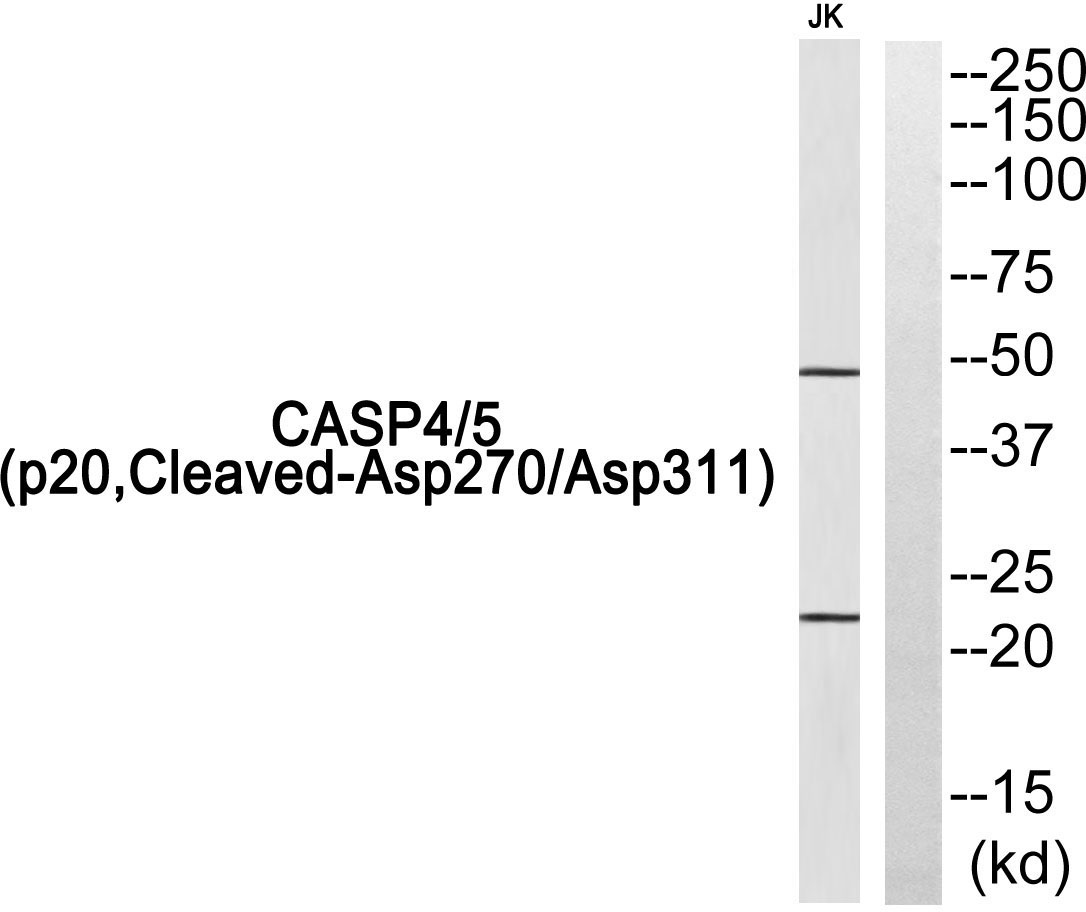Cleaved-Caspase-4/5 p20 (D270/D311) Polyclonal Antibody
- Catalog No.:YC0029
- Applications:WB;ELISA
- Reactivity:Human
- Target:
- Caspase-4/5
- Fields:
- >>Neutrophil extracellular trap formation;>>NOD-like receptor signaling pathway;>>Pathogenic Escherichia coli infection;>>Shigellosis;>>Salmonella infection
- Gene Name:
- CASP4
- Protein Name:
- Caspase4
- Human Gene Id:
- 837
- Human Swiss Prot No:
- P49662/P51878
- Immunogen:
- The antiserum was produced against synthesized peptide derived from human Caspase 4/5. AA range:221-270
- Specificity:
- Cleaved-Caspase-4/5 p20 (D270/D311) Polyclonal Antibody detects endogenous levels of fragment of activated Caspase-4/5 p20 protein resulting from cleavage adjacent to D270/D311.
- Formulation:
- Liquid in PBS containing 50% glycerol, 0.5% BSA and 0.02% sodium azide.
- Source:
- Polyclonal, Rabbit,IgG
- Dilution:
- WB 1:500 - 1:2000. ELISA: 1:40000. Not yet tested in other applications.
- Purification:
- The antibody was affinity-purified from rabbit antiserum by affinity-chromatography using epitope-specific immunogen.
- Concentration:
- 1 mg/ml
- Storage Stability:
- -15°C to -25°C/1 year(Do not lower than -25°C)
- Other Name:
- CASP4;ICH2;Caspase-4;CASP-4;ICE(rel)-II;Protease ICH-2;Protease TX;CASP5;ICH3;Caspase-5;CASP-5;ICE(rel)-III;Protease ICH-3;Protease TY
- Observed Band(KD):
- 47,22kD
- Background:
- This gene encodes a protein that is a member of the cysteine-aspartic acid protease (caspase) family. Sequential activation of caspases plays a central role in the execution-phase of cell apoptosis. Caspases exist as inactive proenzymes composed of a prodomain and a large and small protease subunit. Activation of caspases requires proteolytic processing at conserved internal aspartic residues to generate a heterodimeric enzyme consisting of the large and small subunits. This caspase is able to cleave and activate its own precursor protein, as well as caspase 1 precursor. When overexpressed, this gene induces cell apoptosis. Alternative splicing results in transcript variants encoding distinct isoforms. [provided by RefSeq, Jul 2008],
- Function:
- catalytic activity:Strict requirement for Asp at the P1 position. It has a preferred cleavage sequence of Tyr-Val-Ala-Asp-|- but also cleaves at Asp-Glu-Val-Asp-|-.,function:Involved in the activation cascade of caspases responsible for apoptosis execution. Cleaves caspase-1.,PTM:The two subunits are derived from the precursor sequence by an autocatalytic mechanism or by cleavage by Caspase-8.,similarity:Belongs to the peptidase C14A family.,similarity:Contains 1 CARD domain.,subunit:Heterotetramer that consists of two anti-parallel arranged heterodimers, each one formed by a small and a large subunit.,tissue specificity:Widely expressed, with highest levels in spleen and lung. Moderate expression in heart and liver, low expression in skeletal muscle, kidney and testis. Not found in the brain.,
- Subcellular Location:
- Cytoplasm, cytosol . Endoplasmic reticulum membrane ; Peripheral membrane protein ; Cytoplasmic side . Mitochondrion . Inflammasome . Secreted . Predominantly localizes to the endoplasmic reticulum (ER). Association with the ER membrane requires TMEM214 (PubMed:15123740). Released in the extracellular milieu by keratinocytes following UVB irradiation (PubMed:22246630). .
- Expression:
- Widely expressed, including in keratinocytes and colonic and small intestinal epithelial cells (at protein level). Not detected in brain.
- June 19-2018
- WESTERN IMMUNOBLOTTING PROTOCOL
- June 19-2018
- IMMUNOHISTOCHEMISTRY-PARAFFIN PROTOCOL
- June 19-2018
- IMMUNOFLUORESCENCE PROTOCOL
- September 08-2020
- FLOW-CYTOMEYRT-PROTOCOL
- May 20-2022
- Cell-Based ELISA│解您多样本WB检测之困扰
- July 13-2018
- CELL-BASED-ELISA-PROTOCOL-FOR-ACETYL-PROTEIN
- July 13-2018
- CELL-BASED-ELISA-PROTOCOL-FOR-PHOSPHO-PROTEIN
- July 13-2018
- Antibody-FAQs
- Products Images

- Western blot analysis of Caspase 4/5 (p20, Cleaved-Asp270/Asp311) Antibody. The lane on the right is blocked with the Caspase 4/5 (p20, Cleaved-Asp270/Asp311) peptide.



